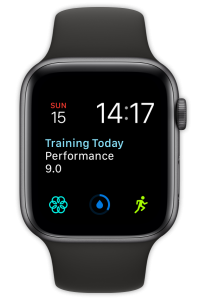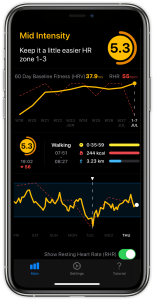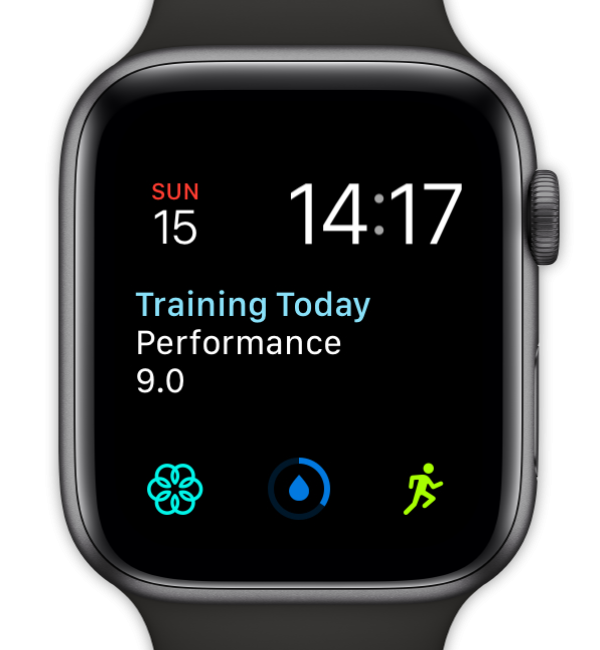We all know that feeling. You know you should get some exercise, but you just don’t feel like it. If you don’t feel up to it, that means your body is telling you to take it easy, right? Well… sometimes yes, sometimes no.
Most weekday mornings I get out for a brisk walk of around half an hour to 40 minutes, which currently is all exercise I get. If I have a rough night’s sleep, the last thing I feel like doing is walking briskly, so I would tell myself that my body needs more rest and not go. But not feeling rested is not the whole story. That’s where the iOS and Apple Watch app Training Today comes in.
Training Today makes use of a health measurement called Heart Rate Variability, or HRV. Here’s what the help in the app says about HRV.
The value of your HRV at any given time is affected by activity in your autonomic nervous system. Essentially fatigue from physical exertion, stress, lack of sleep or a range of other factors will lower the value of HRV. Rest, recovery, and good nutrition to fuel these will raise it. From an athletic perspective, HRV is subsequently a great overall physiological marker – a high HRV might indicate that an athlete is fresh and ready to perform at their best.
 Everyone’s HRV will be different, and it makes little sense to compare values with anyone else, nor even to pay attention to what your absolute value is. The real benefit is in looking for change in your HRV measurement. This is what Training Today does.
Everyone’s HRV will be different, and it makes little sense to compare values with anyone else, nor even to pay attention to what your absolute value is. The real benefit is in looking for change in your HRV measurement. This is what Training Today does.
If you’re wearing an Apple Watch, it’s already recording your HRV. Pop open the Health app, tap Browse, and then Heart. You’ll see among the measurements is HRV. Mine currently says 51ms, but as I mentioned, you shouldn’t measure yourself against mine. Training Today requests access to this measurement along with your resting heart rate — HRV is measured when you are relaxed — and to your workouts. The latter requirement simply serves to include your workouts in the application visuals, so you can see the context of your “Readiness To Train”.
Readiness To Train, or RTT, is how the app boils down its analysis for easy consumption. RTT is a number from 0 to 10, where 10 means you’re at peak performance capability and 0 means you probably shouldn’t get out of bed! The lowest score I have seen was less than 2 after a stressful and sleepless night working.
So… how do you operate the Training Today app? You don’t. Once you have given the requested permission, you can just get on with life and look in when you want the insight it has to offer. You can do that in the app on the iPhone or Watch, or via an iPhone widget or watch complication. I have a medium-sized complication on my watch face which provides a coloured title (it just says “Training Today” but the colour matters), my current score, and a few words to tell me what the score means. Between the colour, score, and words, you get a quick appreciation of your current level of potential. Turquoise, 10, Top Form! Green, 8.3, Strong. Orange, 5.3, Mid Intensity. Pink, 4.2, Low Intensity.
Tapping on the watch complication will take you into the app where you can see more. Here you can see a slightly more wordy appraisal of your score and a graph of the last four days, which you can scroll through with the digital crown.
 You don’t need your iPhone when using Training Today, but your current score can be displayed there, and it contains a lengthy tutorial telling you how everything works. However, a $5.99 in-app purchase gives you a couple of graphs in the iPhone app, one showing a 60-day baseline fitness graph and the other a 7 day RTT graph (similar to the one on the watch) overlaid with your workouts. You can tap to see the score at a particular point, along with details of any workouts marked. Both graphs can be overlaid with your resting heart rate. There is also a simple widget to display your current score in the relevant colour.
You don’t need your iPhone when using Training Today, but your current score can be displayed there, and it contains a lengthy tutorial telling you how everything works. However, a $5.99 in-app purchase gives you a couple of graphs in the iPhone app, one showing a 60-day baseline fitness graph and the other a 7 day RTT graph (similar to the one on the watch) overlaid with your workouts. You can tap to see the score at a particular point, along with details of any workouts marked. Both graphs can be overlaid with your resting heart rate. There is also a simple widget to display your current score in the relevant colour.
A settings screen has a couple of ways to adjust the algorithm used for calculating RTT if you find the app isn’t matching up with what you expect. These settings provide detailed explanations of what they do and when to use them.
Training Today was developed with British Triathlon Coaches and tested on athletes of varying ability, with the goal of taking the relevant health data and displaying a simple, actionable output. Now, I’m no athlete, with my level of exercise not currently exceeding a brisk walk, but I can tell you from my experience with this app, that it is meaningfully accurate.
Let me take you back to the opening of this tale, where I mentioned poor sleep was my excuse for skipping my morning walk. I decided to trust Training Today one morning when I woke up groggy, really not feeling like that walk. After sitting down to a good breakfast, I looked at my score, and it was low end of green. I was, it said, good to go. So, I fought through the malaise and went for my walk. The app was right. After about 15 minutes of walking, I picked up my pace, as I was feeling energised. Instead of the grogginess being a reason not to walk, it turned out the walking was a way to blow away the grogginess.
Because of those days when I don’t feel it, but Training Today tells me to do it anyway, I now also trust it in the reverse situation. Occasionally, I feel like I should probably go for a walk, but the app tells me my score is low, so on those days, I skip my walk or just go for a short stroll. On these occasions, I can often feel that I really do not have the energy.
Training Today is free in the App Store, with the optional $5.99 in-app purchase for the extra iPhone graphs.

